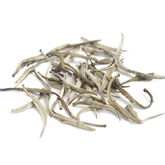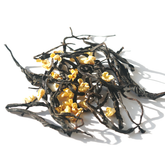How to Store Loose Leaf Tea: Keep It Fresh for Longer
Unfortunately, I often see my Western clients storing their tea incorrectly, which causes the delicious tea to lose its flavor within just a week. How you store tea directly affects its taste and aroma. As a Chinese tea master passionate about tea culture, I deeply understand the sensitivity of loose leaf tea to storage conditions. Proper storage not only extends the freshness of tea but also preserves its original nutrients and captivating fragrance. In fact, the Tea Research Institute of the Chinese Academy of Agricultural Sciences found that 75% of tea spoilage cases are due to improper storage, rather than the quality of the tea itself. If you store tea in glass jars, sunlight passing through the jar can break down the aroma. If green tea isn’t sealed properly and is kept in the fridge, condensation can cause mold to grow (especially in New York summers). Once loose leaf tea is opened and exposed to air, it oxidizes and becomes bitter, much like a cut apple. Worse yet, tea can absorb the smell of leftover food from the fridge.
If you store tea in glass jars, sunlight passing through the jar can break down the aroma. If green tea isn’t sealed properly and is kept in the fridge, condensation can cause mold to grow (especially in New York summers). Once loose leaf tea is opened and exposed to air, it oxidizes and becomes bitter, much like a cut apple. Worse yet, tea can absorb the smell of leftover food from the fridge.
Next, I will explain how to properly store loose leaf tea in everyday life, considering factors like temperature, humidity, and light, to help you keep every cup of tea at its best flavor.
Key Factors That Affect Tea Storage
Tea storage is influenced by temperature, humidity, light, and odors. Tea is like a sensitive ingredient in the kitchen, easily affected by its environment. If the storage temperature exceeds 25°C, it speeds up internal chemical reactions, causing the tea’s fresh flavor to fade—especially green tea, which turns from fresh to bitter. Excess moisture can make tea absorb water and mold, causing black tea’s sweetness to turn sour and promoting mold growth. Light can break down the tea's pigments, making oolong tea lose its floral aroma and turning it into a grassy smell. Odors will make tea absorb unwanted scents from the surroundings. Within three months, these four factors can cause the tea’s aroma to lose half of its potency, its color to darken, and its flavor to become harsh. By understanding these key factors, we can learn the proper way to store tea.
Within three months, these four factors can cause the tea’s aroma to lose half of its potency, its color to darken, and its flavor to become harsh. By understanding these key factors, we can learn the proper way to store tea.
| Factor | Why It Matters | Storage Hacks (With Proof) |
|---|---|---|
| Heat | High temps destroy flavor & aroma. | Keep away from stoves/ovens – Store below 77°F/25℃ (USDA: 40% flavor loss at higher temps). |
| Moisture | Dampness causes mold & stale taste. | Use airtight containers + silica gel – Maintain humidity <60% (ITC: mold risk triples above this). |
| Light | Sunlight bleaches color & nutrients. | Choose opaque tins – Dark containers prevent 3.2x faster nutrient loss (Food Chemistry study). |
| Odors | Tea absorbs smells like a sponge. | Isolate from spices/coffee – Tea absorbs odors 50x faster than coffee beans (ACS research). |
How to Properly Store Tea
Tea storage is affected by temperature, humidity, light, and odors. High temperatures accelerate oxidation and destroy the aroma, so tea should be stored in a cool, dry place, away from heat sources, and, most importantly, out of direct sunlight. Moisture can cause tea to absorb water and even mold, so it’s important to keep the storage environment dry. Using moisture-proof bags or desiccants can help prevent dampness. Light can break down tea components, speeding up oxidation and altering the taste and color, so it’s best to avoid direct sunlight and use opaque containers rather than glass jars. Tea also absorbs surrounding odors, which can affect its flavor, so it’s important to avoid storing tea near strong-smelling items. By paying attention to these factors, you can effectively preserve the freshness and flavor of your tea.
Does Tea Expire?
Does tea have an expiry date?The $24 organic green tea tin you bought from Whole Foods doesn’t have an expiration date, but don’t be fooled—USDA data shows that after six months of being opened, green tea loses 67% of its antioxidants, which is like turning fresh spinach into wilted leaves. Tea doesn’t expire or spoil like food, but over time, it gradually loses its aroma and flavor. In fact, the beneficial compounds in tea begin to break down as it’s stored, causing the taste to become dull or even tasteless. If you notice that your tea has lost its fragrance and the flavor has become bitter or flat, it’s a sign that it’s no longer fresh.
Can You Drink Expired Tea?
Drinking expired tea is generally not a health risk, but the flavor will be noticeably worse. However, if you see mold on the tea leaves or notice a musty, off-putting smell, it means the tea has gone bad and should not be consumed. Moldy tea not only tastes awful but could also be harmful to your health. To prevent this, store your tea in an airtight container, away from light, heat, and humidity. Proper storage helps extend the tea’s shelf life, ensuring that every cup you brew retains its fresh aroma and taste.
Different Tea Varieties and Their Shelf Life
Different types of tea have varying shelf lives, just like the food in your kitchen. For example, green tea, being delicate, is best consumed within 6 months to 1 year after purchase to retain its fresh, grassy aroma. Black tea, which undergoes full fermentation, is more resistant to storage and can last for about 2 years while still maintaining its good flavor. Oolong tea, being relatively complex, usually stays fresh for 1 to 2 years. White tea, which is lightly fermented, can be stored for long periods if kept properly, and its flavor will evolve over time. Pu-erh tea, both raw and ripe, can be stored for long durations, with its aroma and taste undergoing rich transformations as it ages.
No matter what type of tea it is, the key to preserving its flavor is to store it in an airtight container, away from light, heat sources, and humidity, just like you would store spices or coffee beans.
| Tea Type | Best Within | Storage Tips | Notes |
|---|---|---|---|
| Green Tea | 6-12 months | Keep in an airtight container in the fridge (away from strong-smelling foods). | Loses its fresh, grassy flavor quickly if exposed to air or light. |
| Black Tea | 2 years | Store in a dark, sealed jar in your pantry or cupboard. | Check for moisture – it can turn sour if damp. |
| Oolong Tea | 1-2 years | Use vacuum-sealed bags or zipper-lock pouches; keep dry and dark. | Lightly fermented oolong (like jade) fades faster; darker types last longer. |
| White Tea | Ages well (3+ years) | Wrap in foil-lined bags or ceramic jars; avoid heat sources like stovetops. | Develops honey-like sweetness over time – great for sipping later! |
| Raw Pu-erh | Improves for decades | Store in breathable paper wraps in a cool, dry spot (like a closet shelf). | Let it "breathe" – airtight containers stop its natural aging magic. |
| Ripe Pu-erh | Best after 5+ years | Keep in bamboo baskets or clay jars in a dark, dry place. | The earthy "muddy" taste mellows into smooth richness over time. |
SEE MORE CHINESE TEAS
If you have questions about selecting tea:
Learn-more-about-chinese-tea
If you have questions about the benefits of tea:
Health-benefits-of-chinese-tea
If you have questions about brewing tea:
How-to-brew-loose-leaf-tea






